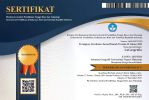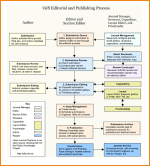Profil Deforestasi di Daerah Aliran Sungai Maros Provinsi Sulawesi Selatan
(1) Jurusan Geografi Fakultas Matematika dan Ilmu Pengetahuan Alam Universitas Negeri Makassar
(2) Jurusan Geografi Fakultas Matematika dan Ilmu Pengetahuan Alam Universitas Negeri Makassar
(3) Jurusan Geografi Fakultas Matematika dan Ilmu Pengetahuan Alam Universitas Negeri Makassar
(*) Corresponding Author
DOI: https://doi.org/10.35580/lageografia.v21i2.43243
Abstract
Oxygen is an important requirement for human life. Oxygen is produced by forests. As population growth increases, the need for land use also increases, so that forest land is deforested. This study aims to determine the dynamics of forest land change and the profile of deforestation in the Maros River Basin. This study uses quantitative analysis with a descriptive approach. The data used in this study is land cover data in the form of shapefiles obtained from the Makassar Region VII Forest Area Consolidation Agency, which is then processed using a Geographic Information System (GIS). The results of the analysis show that for 30 years (1990-2020) the forest area has decreased by 1,057.90 hectares. Changes in forest land to shrubs, settlements/built-up land, savanna/grasslands, bodies of water, mixed gardens, and rice fields. The most preferred residential land use. The results for the deforestation profile in the Maros watershed obtained 4 different types of deforestation profiles, where overall the majority of the Maros watershed are not vulnerable to deforestation
Abstrak
Oksigen merupakan kebutuhan penting bagi kehidupan manusia. Oksigen dihasilkan oleh hutan. Dengan meningkatnya pertumbuhan penduduk, kebutuhan akan penggunaan lahan juga meningkat, sehingga lahan hutan mengalami deforestasi. Penelitian ini bertujuan untuk mengetahui dinamika perubahan lahan hutan dan profil deforestasi di DAS Maros. Penelitian ini menggunakan analisis kuantitatif dengan pendekatan deskriptif. Data yang digunakan dalam penelitian ini adalah data tutupan lahan berupa shapefile yang diperoleh dari Badan Pemantapan Kawasan Hutan Wilayah VII Makassar, yang kemudian diolah menggunakan Sistem Informasi Geografis (SIG). Hasil analisis menunjukkan bahwa selama 30 tahun (1990-2020) luas hutan mengalami penurunan sebesar 1.057,90 hektar. Perubahan lahan hutan menjadi semak belukar, pemukiman/lahan terbangun, sabana/padang rumput, badan air, kebun campur, dan persawahan. Penggunaan lahan perumahan yang paling disukai. Hasil profil deforestasi di DAS Maros diperoleh 4 jenis profil deforestasi yang berbeda, dimana secara keseluruhan sebagian besar DAS Maros tidak rentan terhadap deforestasi.
Keywords
Full Text:
PDFReferences
Busch, J., & Ferretti-Gallon, K. (2017). What drives deforestation and what stops it? A meta-analysis. Review of Environmental Economics and Policy.
Christiawan, P. I. (2018). Cultural landscape: A bridge between deforestation and local community? Journal of Landscape Ecology, 11(2), 77–87.
Davis, K. F., Koo, H. I., Dell’Angelo, J., D’Odorico, P., Estes, L., Kehoe, L. J., Kharratzadeh, M., Kuemmerle, T., Machava, D., & Pais, A. de J. R. (2020). Tropical forest loss enhanced by large-scale land acquisitions. Nature Geoscience, 13(7), 482–488.
Jusys, T. (2018). Changing patterns in deforestation avoidance by different protection types in the Brazilian Amazon. PLoS One, 13(4), e0195900.
Kele, S. (2009). Changes in carbon storage and oxygen production in forest timber biomass of Balci Forest Management Unit in Turkey between 1984 and 2006. African Journal of Biotechnology, 8(19).
Kementerian Lingkungan Hidup dan Kehutanan (KLHK). (2021). Deforestasi Indonesia Tahun 2019-2020.
Mackey, B., Kormos, C. F., Keith, H., Moomaw, W. R., Houghton, R. A., Mittermeier, R. A., Hole, D., & Hugh, S. (2020). Understanding the importance of primary tropical forest protection as a mitigation strategy. Mitigation and Adaptation Strategies for Global Change, 25(5), 763–787.
Meletis, C. D., & Wilkesa, K. (2019). The Crucial Role of Oxygen for Health. Journal of Restorative Medicine, 8(1).
Petrenko, C., Paltseva, J., & Searle, S. (2016). Ecological impacts of palm oil expansion in Indonesia. Washington (US): International Council on Clean Transportation, 1–21.
Puyravaud, J.-P. (2003). Standardizing the calculation of the annual rate of deforestation. Forest Ecology and Management, 177(1–3), 593–596.
Rahim, S., & Baderan, D. W. K. (2017). Hutan mangrove dan pemanfaatannya. Deepublish.
Rijal, S., Saleh, M. B., Jaya, I. N. S., & Tiryana, T. (2016). Spatial Metrics of Deforestation in Kampar and Indragiri Hulu, Riau Province. Jurnal Manajemen Hutan Tropika, 22(1), 24.
Rosa, F. P. (2018). Profil Deforestasi di Provinsi Sulawesi Tengah dan Sulawesi Tenggara. Universitas Hasanuddin.
Sahide, M. A. K., Nurrochmat, D. R., & Giessen, L. (2015). The regime complex for tropical rainforest transformation: Analysing the relevance of multiple global and regional land use regimes in Indonesia. Land Use Policy, 47, 408–425.
Sunderlin, W. D., & Resosudarmo, I. A. P. (1997). Laju dan penyebab deforestasi di Indonesia: penelaahan kerancuan dan penyelesaiannya. Centre for International Forestry Research.
Turubanova, S., Potapov, P. V, Tyukavina, A., & Hansen, M. C. (2018). Ongoing primary forest loss in Brazil, Democratic Republic of the Congo, and Indonesia. Environmental Research Letters, 13(7), 74028.
Wahyuni, H., & Suranto, S. (2021). Dampak deforestasi hutan skala besar terhadap pemanasan global di Indonesia. JIIP: Jurnal Ilmiah Ilmu Pemerintahan, 6(1), 148–162.
Wang, F., Harindintwali, J. D., Yuan, Z., Wang, M., Wang, F., Li, S., Yin, Z., Huang, L., Fu, Y., & Li, L. (2021). Technologies and perspectives for achieving carbon neutrality. The Innovation, 2(4), 100180.
Article Metrics
Abstract view : 206 times | PDF view : 42 timesRefbacks
Copyright (c) 2023 Nasiah Badwi, Muhammad Yusuf, Muh. Chaeril Anam

This work is licensed under a Creative Commons Attribution-NonCommercial 4.0 International License.
LaGeografia: Jurnal Program Studi Pendidikan Geografi, Jurusan Geografi, Fakultas MIPA, Universitas Negeri Makassar.
Email: lageografia@unm.ac.id | +6285298749260
Editorial Office













































